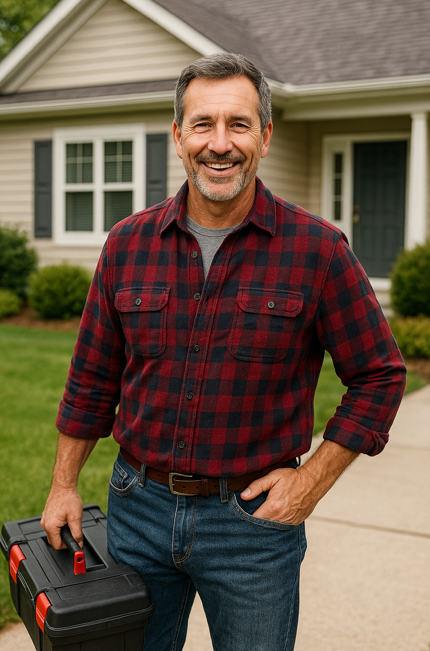So, you picked up a Goodman 20 kW Electric Furnace (MBVK20DP1X00 + HKTAD201)—solid choice. The big question now is: Can you install it yourself?
As a regular homeowner who’s not afraid to get his hands dirty, I’ll walk you through what you need to know before you bust open the box. You don’t need to be an HVAC pro, but you do need to follow code, respect electricity, and use a little common sense.
Let’s get into it.
🧰 Step 1: Pre-Installation Checklist
Before anything else, make sure you’ve got:
✅ Required Tools:
-
Cordless drill & impact driver
-
Sheet metal snips
-
Tape measure
-
Level
-
Wire cutters/strippers
-
Multimeter
-
Voltage tester
-
Screwdrivers (flat and Phillips)
-
Electrical connectors (wire nuts or terminal blocks)
-
8 AWG or 6 AWG copper wire (depending on local code & amperage)
🧾 Required Supplies:
-
Electrical whip or flex conduit
-
2-pole breaker sized per unit specs (100A for full 20kW)
-
Sealant or mastic for duct seams
-
Mounting brackets or platform
📜 Permits & Code Check:
This is a big one. Always check your local building codes before starting. Some jurisdictions require a licensed electrician for wiring, or a final inspection for safety.
Want to know more about electric furnace code requirements? Here’s a great primer from The Spruce on what to look for.
📦 Step 2: Unboxing and Inspecting the Unit
Open the box and verify you’ve received:
-
Goodman MBVK20DP1X00 Air Handler/Furnace Cabinet
-
HKTAD201 20 kW Heat Kit (factory-installed or packaged separately)
-
Instruction manuals and warranty paperwork
Inspect everything for dents, broken panels, or disconnected internal wires. Trust me, it’s easier to spot issues now than after you’ve mounted it in your crawlspace.
Goodman includes downloadable manuals—grab them directly from the Goodman HVAC literature library.
🪚 Step 3: Mounting the Furnace
The Goodman MBVK series is a multi-position unit, so you can install it vertically (upflow or downflow) or horizontally. Most homeowners will go vertical upflow if it’s in a closet or utility room.
Mounting Tips:
-
Set it on a level surface or platform.
-
Leave at least 1 inch of clearance on all sides for airflow and service access.
-
If placing in a garage or attic, raise it at least 4 inches above the floor to meet code.
-
Anchor it using mounting brackets or corner tabs and secure with screws.
Before you wire anything, double-check duct alignment. A misaligned plenum = major headaches later.
⚡ Step 4: Wiring the HKTAD201 Heat Kit
This is the part where a lot of homeowners get nervous—and honestly, you should respect this part. We’re dealing with high voltage.
General Wiring Process:
-
Turn off the main breaker at your panel.
-
Remove the front access panel and locate the HKTAD201 wiring lugs.
-
Run appropriate gauge wire from your breaker panel to the furnace disconnect box.
-
Connect ground wire to the grounding lug.
-
Connect line voltage (L1 and L2) to the designated terminals.
-
If required, install a low-voltage thermostat wire from your wall stat to the control board.
Check your local code for exact breaker size and wire gauge. In most cases, 20 kW needs 100A service and 3-wire 6 AWG copper.
💨 Step 5: Connecting Ductwork and Airflow Setup
This Goodman unit puts out 2,000 CFM, which should be plenty for most medium-sized homes. But airflow only works if your ductwork cooperates.
Ducting Advice:
-
Ensure the return duct is sealed tightly with mastic or foil tape.
-
Supply plenum should transition smoothly with minimal restrictions.
-
Avoid sharp 90° turns near the air handler.
-
Seal every joint. Leaky ducts kill efficiency and cost you money.
🔥 Step 6: Power Up and Test the System
Now for the moment of truth.
-
Flip the breaker back on.
-
Set your thermostat to “heat” and crank it up.
-
Watch the sequencer engage (you’ll hear a click) and the blower kick on after a short delay.
-
Feel for warm air at the registers.
Use a multimeter to test voltage if it doesn’t start. Also check for tripped breakers, loose connections, or open limit switches.
✅ Final Tips from Mike
-
Label everything: Your panel, your thermostat wires, your disconnect.
-
Take photos before closing things up. If you need to call a pro later, they’ll thank you.
-
Register your warranty with Goodman after install. This ensures you're covered if anything goes south.
And one final word of advice: If you’re at all unsure about the wiring, hire a licensed electrician. You’ll sleep better.
🏁 Wrapping Up
Installing your own 20 kW Goodman electric furnace is doable—but it’s not plug-and-play. You need the right tools, time, and attention to detail.
The good news? Once it’s in, you’ve got reliable, quiet, combustion-free heat that’s perfect for mobile homes, additions, or any space without natural gas.
Still got questions? Drop me a message or check out The Furnace Outlet for more homeowner-friendly HVAC guides and gear.
Stay warm,
– Mike
Homeowner. DIYer. Furnace nerd by necessity







